The Best Free Survey Tools
We’re a small company with enough things to spend money on. Creating surveys for clients isn’t something we do frequently enough (yet) to justify the monthly cost of tools like SurveyMonkey or SurveyGizmo, so we went on a hunt for the best free survey tool.
Survey Tool Requirements
Our baseline requirements for basic surveys are:
- Ask ~20 questions
- Get unlimited results
- Create matrix rating questions (e.g. asking the respondent to rate a number of different items on the same scale, such as from very unlikely to very likely)
- View individual and tabulated results
- Export results
Overview of Free Plans
Here is a summary of the free plans of tools that we tested, in alphabetical order.
| Survey Tool | ThinkUX rating* | Number of surveys | Number of questions | Number of responses | Matrix rating questions | Export results |
|---|---|---|---|---|---|---|
| Google Forms | 9.5 | unlimited | unlimited | unlimited | yes | yes |
| SurveyGizmo | 8 | 3 | unlimited | 100 / survey | no | yes |
| Survey Hero | 6 | unlimited | unlimited | unlimited | no | no |
| Survey Monkey | 7.5 | unlimited | 10 / survey | 100 / survey | yes | yes |
| Survey Planet | 3 | unlimited | unlimited | unlimited | no | no |
| Zoho Survey | 5 | unlimited | 15 / survey | 150 / survey | yes | no |
* The ThinkUX rating has a maximum score of 10, and is a subjective number based on the following factors: the ability of each tool's free plan to meet the requirements laid out above, the UX of the tool, and the aesthetic appeal of the tool and its surveys. We are in no way associated with any of these companies.
Google Forms
ThinkUX rating: 9.5 / 10
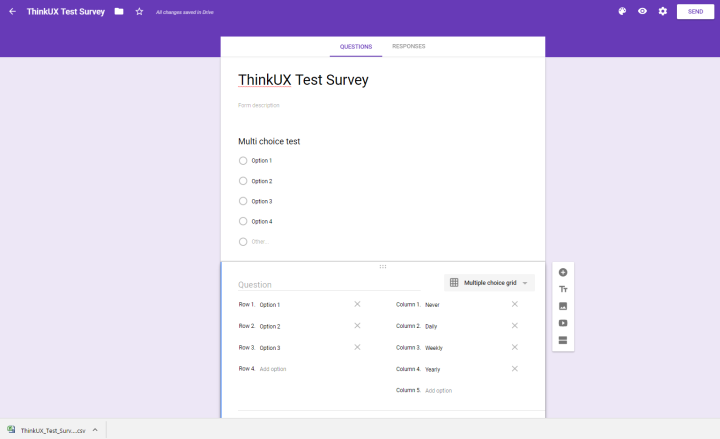
The good
I stopped reviewing other tools after I reviewed Google Forms. There was no need to continue. In typical Google fashion, it does almost everything we needed it to do in a very intuitive manner. You can create unlimited surveys, with unlimited questions, and collect unlimited responses. It supports matrix questions, allows you to export data directly into Google Sheets, see individual and tabulated responses, and lay out your survey exactly as you please. Notably, Google Forms includes logic for skipping questions based on earlier responses. This is a rare and beautiful thing in a free tool.
The bad
All in all, for a free tool, this is quite an incredible product. If I’m nitpicking:
- The aesthetic is less appealing than some of the other tools.
- It doesn’t support as many question types, and the question types don’t have as many features (for example, you can’t have a textbox beside a multiple choice/checkbox answer) but I haven’t run into a situation yet that I needed to do something that I couldn’t find a work-around for.
- The inability to move pages around is a nuisance.
SurveyGizmo
ThinkUX rating: 8 / 10
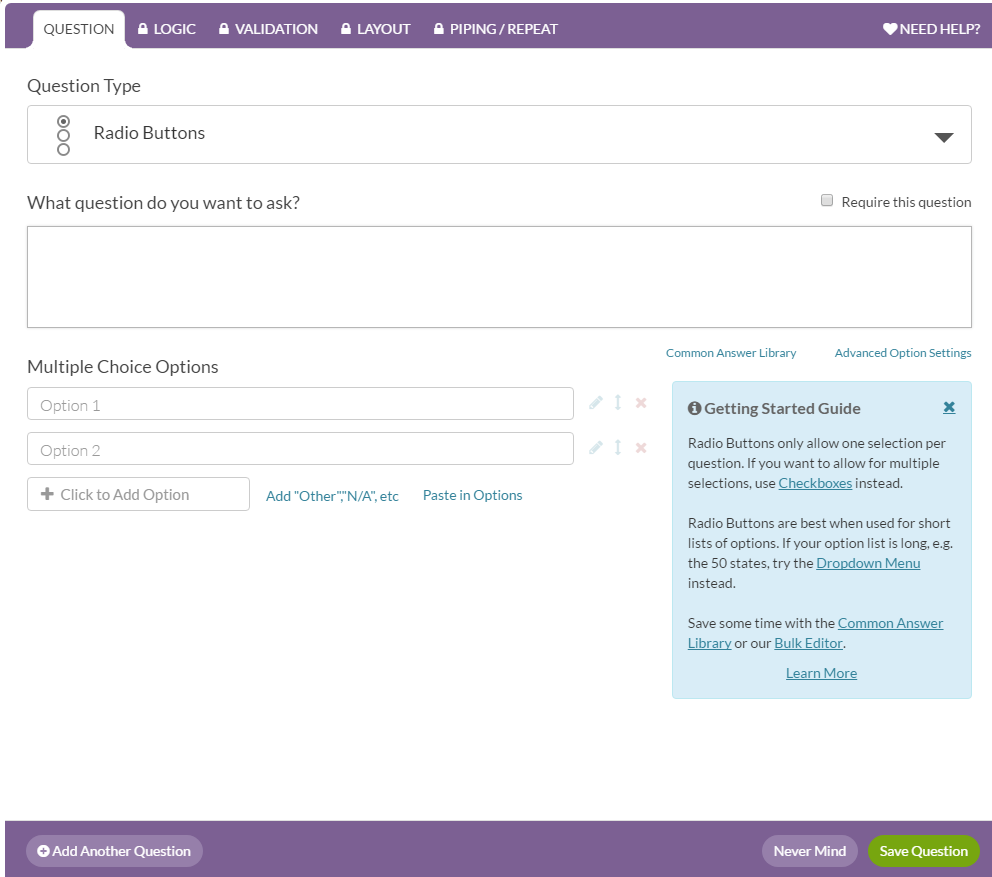
The good
The SurveyGizmo interface is very clean and user friendly. They have some neat metrics for each survey on the dashboard, like fatigue score and accessibility, as well as the estimated survey length in minutes (though this seems to disappear after collecting responses). Creating surveys and adding questions is a breeze.
Survey results are also very well done. You can view individual responses, and create reports of tabulated responses. The reports are customizable so you can choose which type of chart to display, or to filter your data on a per-question basis.
The bad
- Free Plan Show-stopper: you can’t create matrix questions.
- Can’t customize the look and feel of your survey.
These drawbacks are unfortunate, because other aspects of the tool are very well done.
SurveyHero
ThinkUX rating: 6 / 10
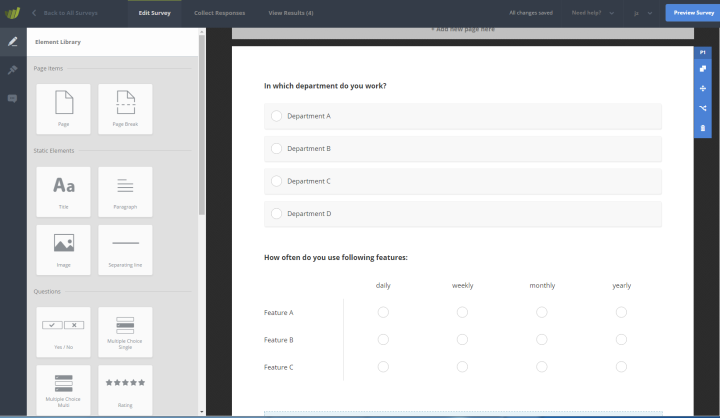
The good
The drag and drop interface for creating questions and surveys is very intuitive. You can lay your survey out just the way you want to. Also, you can create matrix questions! Sure, they’re not perfect visually (e.g. the rankings appear to run together and are not visually distinct), but you can create them, which is a plus.
The bad
- Can’t export results
- When viewing results, you can’t change chart types or get necessary data
Both of these drawbacks are Free Plan Show-stoppers. The inability to change chart types when viewing results is acceptable for some question types (such as multiple choice), but for data matrix questions the results displayed in the default chart are fairly useless. It doesn’t even tell you the distribution of the responses (e.g. how many people selected each rating for each row)! It only shows mean and variation, which are not very helpful in a matrix. If you want that data you have to either tabulate it yourself (good luck) or upgrade to a paid plan.
SurveyMonkey
ThinkUX rating: 7.5 / 10
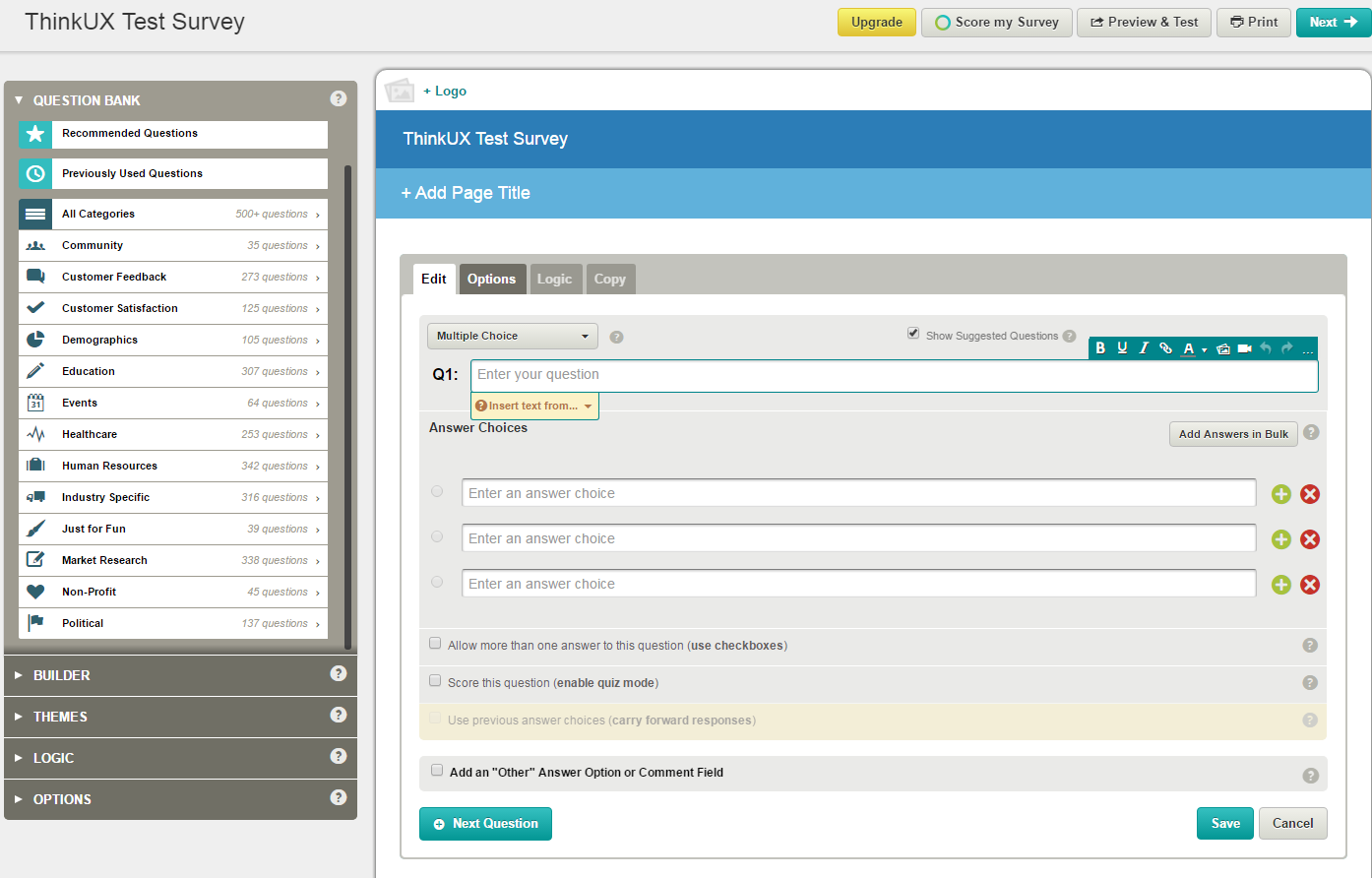
The good
SurveyMonkey is probably the most well-known survey tool out there. It’s easy to use, visually appealing, and very feature rich.
The bad
- Can’t export results
- Limited to 10 questions per survey
- Limited to 100 responses per survey
These drawbacks are Free Plan Show-stoppers. While there’s no denying the ease of creating surveys using SurveyMonkey, the fact that the free plan limits you to 10 questions makes it severely limited, and in almost all cases, unusable as a free option. Furthermore, the UX of this limitation is itself frustrating: SurveyMonkey will allow you to create an entire survey and test it out before telling you that the free plan only allows 10 questions. There is no warning when you add an 11th, 12th, or 20th question. Only when you’re ready to send it out to participants will you find out that the free plan is limited to 10 questions.
This is deceptive, which is not a great feeling to evoke in potential customers.
SurveyPlanet
ThinkUX rating: 3 / 10
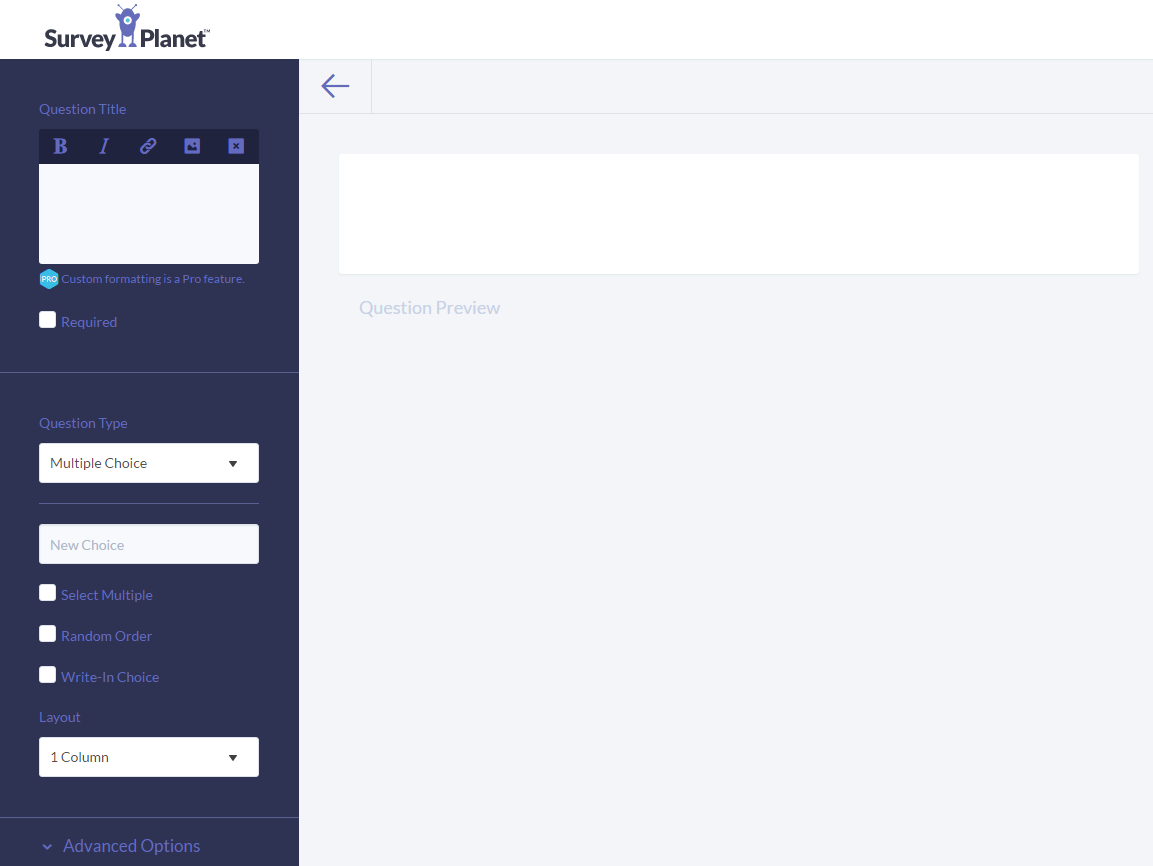
The good
You can create unlimited surveys and questions, and collect unlimited responses. If you need to create very simple surveys, this might meet your needs. You can customize the survey design in the free plan. Also, it’s easy to prevent multiple submissions from the same device.
The bad
- Can’t create matrix questions.
- Can’t change chart types when viewing results.
- Can’t export data.
These drawbacks are Free Plan Show-stoppers. Overall, the interface is a bit clunky, and it’s not a feature-rich survey tool. Matrix questions aren’t available in either the free or the paid plans. When viewing results, you can’t change chart types in the free plan, nor can you export data. Additionally, there is no option to add pages or change how the survey is delivered to participants: it’s one question at a time.
Zoho Survey
ThinkUX rating: 5 / 10
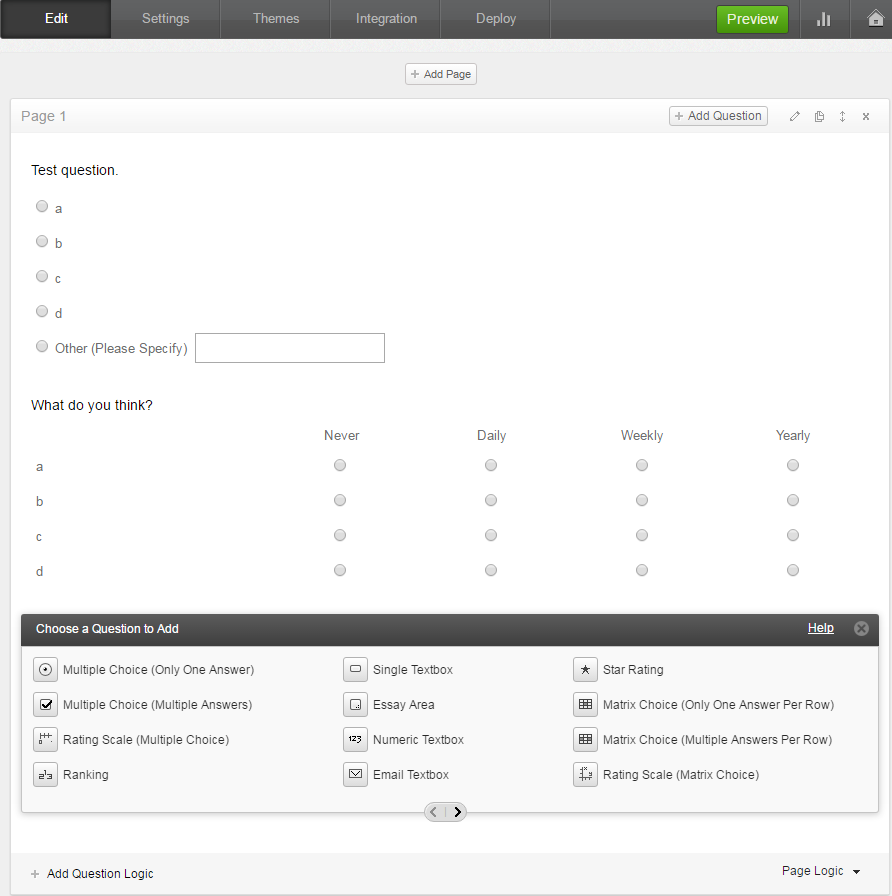
The good
Zoho Survey, for it’s lack of visual appeal, does a very good job of creating surveys. It supports creating matrix questions in the free plan, and adding new questions and pages is simple.
The bad
Free Plan Show-stopper: can’t export results or customize reports. The major disappointment with this tool is the inability to export data and customize reports in the free plan. Visually, I would liken it to desktop software written by developers for power users. It feels a little like the 90s. It’s very efficient, but not very aesthetically pleasing.
Summary
By no means does this cover all of the survey tools with free plans that are out there. In fact, it barely scratches the surface. We reviewed some of the most common tools, and stopped when we found one that was acceptable for our current purposes. We’re currently using Google Forms for our user surveys, and should the time arise where we want to improve on Google Forms’ flat and uninspiring visual design, we will likely look more deeply at paid plans for SurveyGizmo and SurveyMonkey.
Hope this helps, and happy surveying!
